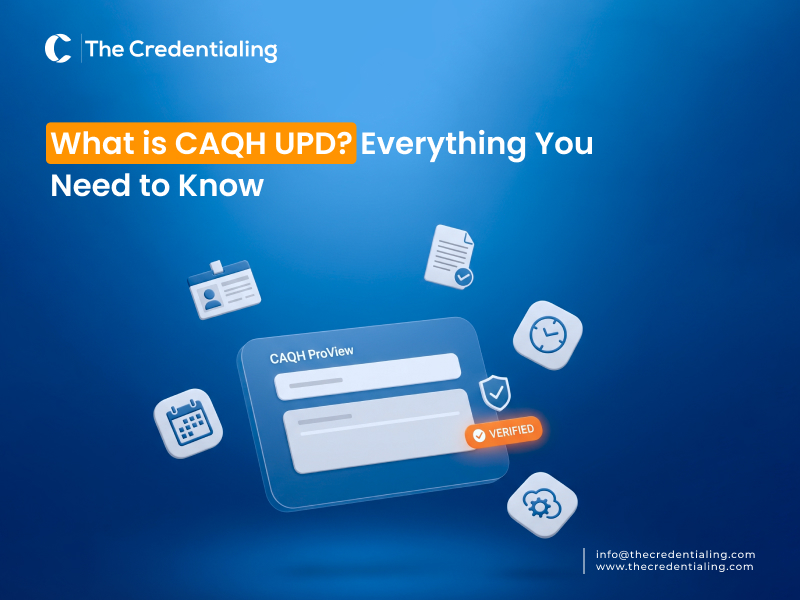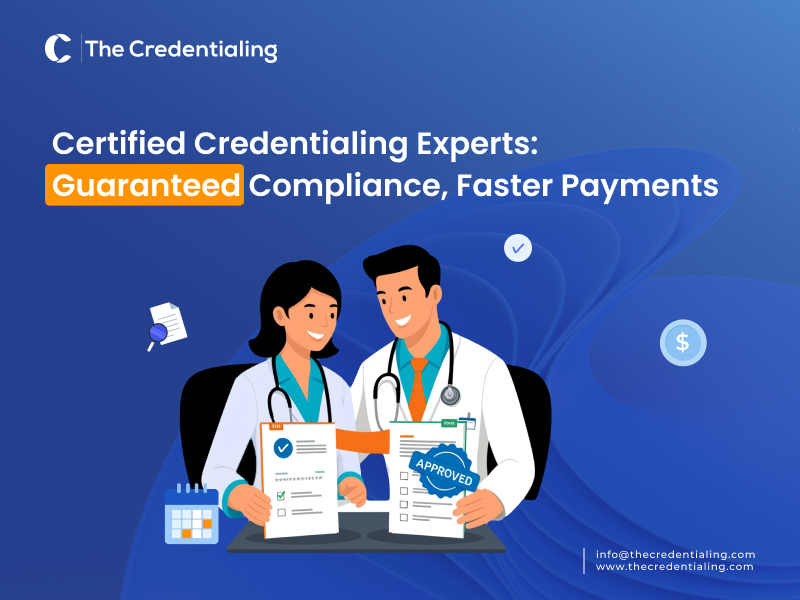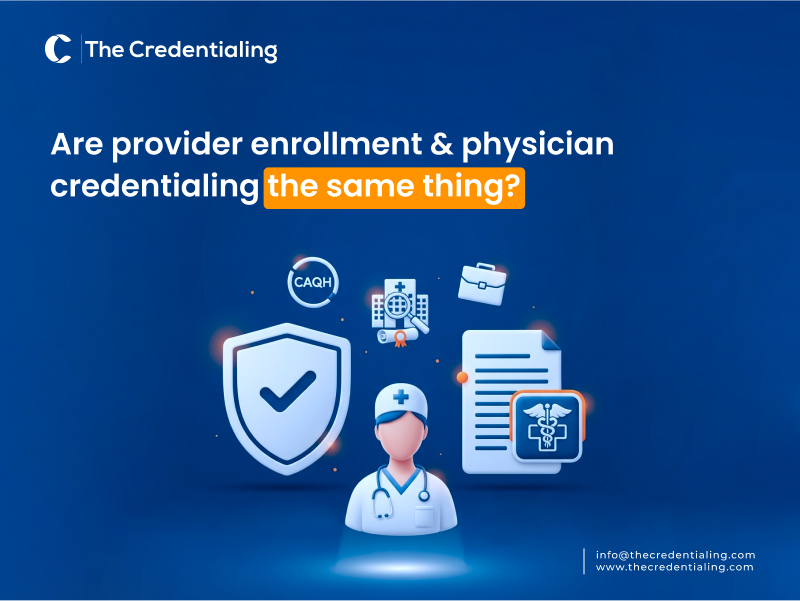What is CAQH UPD? Everything You Need to Know
Discover the leading medical credentialing companies of 2025. Find trusted partners to reduce claim denials and speed up approvals.
Schedule Free Demo Today
The previous year’s index showed more than 600 medical and dental provider organisations and health plans covering 63% of insured lives, yet relying on manual tasks created critical challenges within Healthacre Revenue Cycle Management (RCM). The manual data entry and handling of paperwork drive costs while making patient care access a trouble.
The inefficiencies, such as outdated medical records and regulatory requirements, create hurdles such as delayed treatments and strained provider resources. Amidst all that, the industry proceeds further to bring a shift in processes (Adapting with the advanced tech and automation) to streamline healthcare RCM. Real-time data exchange, accuracy as the priority, and targeted information for immediate action are more than the need of the hour.
CAQH UPD or the Provider Data Portal holds the capability to advance interoperability, reduce delays, lower costs and improve patient care. With this digital system that centralizes the provider data, many tasks are handled without the risk of inefficiency or data breaches.
This is a common platform for healthcare providers and payers to facilitate the data transition, enhance communication, and improve the speed of administrative workflow, especially when working for provider credentialing. Therefore, the providers have an expanded network of insurance payers and a larger patient base.
Learn in this guide all the ins and outs of what CAQH UPD is and its advanced version to accelerate your practice's administrative performance and, similarly, the revenue flow.
What is CAQH UPD (ProView)? The Term’s History & Transition!
The CAQH UPD (Universal Provider DataSource) is the centralized digital system that was created by the Council for Affordable Quality Healthcare (CAQH). Primarily, the purpose of building this database was to provide healthcare providers with a single platform (a single source of truth) to store and maintain their personal and professional information, thereby supporting their credentialing process.
This sensitive data can then be accessed only by the authorized healthcare organizations for credentialing, claims administration, and other necessary functions in medical billing.
In 2015, UPD was transitioned into a more modern and secure platform for provider data management known as CAQH ProView. It is a widely used platform that helps providers collect, maintain, and share data across the U.S.
The CAQH UPD or ProView standardizes the credentialing data management through automated efficiency. Since the submission and update of licensure, education, and insurance details is on the spot, healthcare providers avoid the need for the same information submission to multiple payers, which saves them significant time while access for the payers is easier.
The system enhances the data accuracy and consistency across healthcare organizations through digital document uploads, e-signatures, and attestations every 120 days. The CAQH digital portal’s automated reminders and validation checks keep providers compliant by keeping the data up-to-date without the risk of errors and inefficiencies.
Why CAQH Data Portal important in Healthcare?
The point of CAQH Proview or CAQH Data Portal is an important system used across the healthcare industry to serve the multiple healthcare bodies involved, such as healthcare providers, insurance payers, and other healthcare organisations. They can easily access the provider credentials such as licenses, training, liability insurance and more while ensuring the data is correct and up-to-date.
As per the current data, more than 2.5 million healthcare providers, 100k dentists, and 1000 health plans, hospitals, and other healthcare organisations participate in this digital system to simplify credentialing. With such a vast usage of the system, there is the facility of streamlined communication among the providers and payers, ensuring a standardized data entry, less administrative burden, and data redundancy.
This data is then used by the public and commercial payers across the country to address the many provider network uses, including credentialing, network and referral management, provider directories, and more.
Moreover, the CAQH ProView helps providers generate a complete credentialing application which is accepted across all 50 states of the US and even those with specific credentialing requirements. With the constant updates of this system, the professionals can proceed with new federal and state regulatory requirements.
Such process efficiency contributes to the practice revenue as provider onboarding and reimbursement are handled without hurdles. CAQH ProView helps providers support re-attestations and automated updates to stay compliant with payer requirements. Overall, the system helps practices enhance operational performance and payer coordination in a critical healthcare environment.
The Key Features & Functions of CAQH UPD/ProView
CAQH UPD or the digital provider portal is a streamlined automated system for healthacre providers to manage credentialing data with complete encrypted security of access. It is a single platform for multiple healthcare providers (individual or group practices) to upload documents, including state licenses, DEA registrations, malpractice insurance, and board certifications, to keep all the credentials safe in one place.
The key features of the system include the CAQH Practice ProView Module, which ensures the manager’s data entry at one time for multiple providers. This data helps create the individual provider profile. The system also accepts a user’s single account for multiple groups with multiple TINS (Tax Identification Number), which enables providers/practice managers can use the single account to set up different groups with different states. Below is the breakdown of key features of how the CAQH UPD works:
-
Providers requiring any specific state application questions may create a different “practice” for each state.
-
CAQH ProView Practice Manager Module also offer “Bulk Upload” to assist large practices with data entry for multiple providers.
-
Practices uploading the data file in the required file format specifications, process it by the CAQH, and automatically exporting it to the individual provider data profile.
-
This information is available for import within each provider profile.
-
Payers can also access more information within the “bulk upload function” on the “resource page”.
-
CAQH ProView also has the Export/Import option that works in the following ways:
-
The practice manager exports the data for multiple providers to the individual provider data profiles.
-
This data is then available for providers to import into their data profiles.
-
There is also an “import” button that becomes activated within the section of available data for import.
-
Providers can choose the accept or reject the available data.
-
The uploaded data (imporetd) may be edited before the provider saves and attests to the information.
What is the link between the CAQH number and provider NPI?
CAQH UPD have an electronic signature functionality that ensures providers that the submissions are valid. On the other hand, there are automated alerts that notify them of upcoming document expirations and required re-attestation every 120 days for regular compliance.
Amidst the entire process, each provider is assigned a CAQH number linking to their NPI (National Provider Identifier) for identity verification across payers. These systems' features ensure efficient credentialing management for providers while reducing paperwork and errors.
The centralized data functionality of the systems makes provider data management more efficient and ready for payers to ensure smooth workflow and timely reimbursement.
A Step-by-Step Process for Providers to Get Started with the CAQH ProView
Here’s a smooth go-through of the steps for providers to get started with CAQH ProView:
-
To get started with the CAQH for Credentialing, a provider may receive an invitation from a health plan.
-
Or, they can go directly to CAQH ProView and register as a new provider.
-
Providers need to use their NPI number to begin the registration or use the CAQH credentialing login.
-
Once the system verifies the number, they will fill out all required sections, including personal details, practice locations, education, licensure, work history, and professional references.
-
Upload the required documents, including state licenses, DEA certificates, malpractice insurance and board certifications.
-
Providers sign the application to confirm the data's accuracy. However, Re-attestation is required every 120 days to remain compliant.
-
Link your CAQH profile to specific payers so they can retrieve your data directly for credentialing and contracting.
However, make sure you are double-checking the missing or expired documents, which is the best strategy to avoid issues. Providers can also keep digital copies of credentials ready before the process begins. Also, setting reminders for re-attestation and document renewals is safe to secure hurdles.
Common Provider Questions:
How can I obtain a CAQH provider ID number?
CAQH UPD creates the CAQH provider ID numbers when a new provider is submitted to the organisation’s roster or when the provider gets registered with the system.
Where to access the “Authorisation” screen for editing the organisation that views my data?
Providers can access the “Authorization” page located in account settings. Click on the gear icon in the upper right corner of the page, and there you will select the “Authorization” item from the menu.
Can I delete a primary practice location once entered and saved?
Yes, by navigating the practice locations tab in the provider view, you can select the “archive link” for the record you need to delete.
Why does CAQH still collect UPIN?
CAQH Proview includes UPIN at the request of some health plans that use UPIN to link the data within their internal systems.
What information is needed to complete the CAQH profile?
For providers to complete their CAQH Profile, they need an NPI number, personal contact details, practice location, education history, licensure and certification details, DEA and malpractice insurance information professional reference and current CV. Such information is stored in CAQH for providers to facilitate many processes in healthcare and credentialing on the top.
How frequently does a provider need to physically sign the attestation release form?
The provider only needs to sign the attestation form during the first attestation process. They can complete further re-attestations on the system without the need for additional signed copies.
What happens if I don’t update my CAQH?
If you fail to update your CAQH profile or complete re-attestations every 120 days can result in delays and denials in credentialing, missed payer deadlines, and claim rejections.
Some EndNotes: Streamlining Provider Credentialing with CAQH
CAQH ProView will continue to advance healthcare credentialing by offering providers and organizations reliable tools, seamless integrations, and ongoing support. One of its most practical features he CAQH number Lookup by NPI helps verify if a provider is registered, improving accuracy in payer applications. Integration with credentialing software further reduces manual data entry, enhances data consistency, and speeds up approval timelines.
Furthermore, CAQH also supports the users with help desk assistance, knowledge centres, and user guides. This feature resolves common issues and ensures smooth navigation of the platform. For providers, credentialing staff, and healthcare organizations alike, these tools make CAQH ProView not just a data repository but a critical system for ensuring compliance, reducing administrative delays, and supporting efficient revenue cycle management.
TheCredentialing is the top credentialing company for physicians that offers a professional provider credentialing process with complete efficiency and integration with the CAQH ProView. Let us know whether you need single-provider credentialing or group practice data entry. We will make each step of your credentialing and enrollment a breeze with our automated credentialing portal.
Since healthcare needs more advanced systems for data collection and management, TheCredentialing goes a step further to enhance your practice billing and RCM by integrating with automation.
Sit Back and Relax! Let The Pros Handle Credentialing For You!
thecredentialing has built a strong portfolio while providing credentialing services to clients over the years. Our service includes helpful features that you won’t find anywhere else.
Schedule Free Demo Today!
